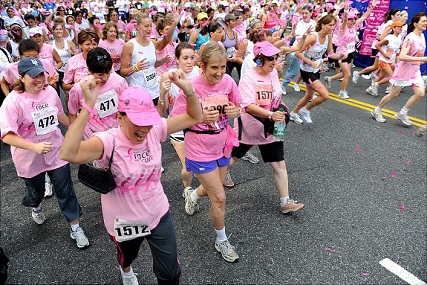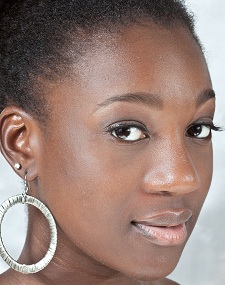 We are in the final days of Breast Cancer Awareness month. We’ve all seen people sporting pink ribbons in various ways and heard it mentioned on the news and other television programs. The bombardment of encouragement for screening and the inundation of information on breast cancer is a WONDERFUL thing! After all, so many lives are affected by this disease. I’m willing to bet that most of us have come into close contact with it, whether through friends, family members, co-workers, or even ourselves. I’m a firm believer that you are never too young to find out about it and the positive impact of early detection. Hosea 4:6 says, “My people perish from a lack of knowledge…” Although it wasn’t in discussion of Breast Cancer Awareness, it can most certainly be applied.
We are in the final days of Breast Cancer Awareness month. We’ve all seen people sporting pink ribbons in various ways and heard it mentioned on the news and other television programs. The bombardment of encouragement for screening and the inundation of information on breast cancer is a WONDERFUL thing! After all, so many lives are affected by this disease. I’m willing to bet that most of us have come into close contact with it, whether through friends, family members, co-workers, or even ourselves. I’m a firm believer that you are never too young to find out about it and the positive impact of early detection. Hosea 4:6 says, “My people perish from a lack of knowledge…” Although it wasn’t in discussion of Breast Cancer Awareness, it can most certainly be applied.
What Is It?
Our bodies were created in a way where cells are constantly growing, dividing, and dying. Sometimes some cells ‘miss the memo’ and begin to grow out of control, forming a lump that we refer to as a tumor. Tumors can either be malignant (meaning they consist of cancerous cells) or benign (not cancerous). When this malignant tumor is found in breast tissue, it’s referred to as breast cancer. (Unfortunately, these cells can break away and travel to other parts of the body and take up residence. This is called “metastasis”.) This abnormal cell growth can either be due to a genetic mutation (a family trait) or spontaneous. According to the Susan G. Komen foundation, spontaneous mutations account for about 90-95% of all breast cancer cases in the States.
Early Detection
As per the American Cancer Society, the majority of doctors feel that early detection saves thousands of lives a year and that many more could be saved if more women took advantage of the screening that is available (The term “screening” refers to tests or procedures that can be used to find a condition, without symptoms). Following the ACS’s guidelines for early detection significantly improves that chances that it can be diagnosed early and treated successfully. The earlier breast cancer is found, the more treatment options and improved chances of survival. (Note: no one of the screening methods below replaces another. They should be done in conjunction with each other.)
· Mammograms: Thus far, this is the best screening tool available today. It uses x-ray imaging to look at the breast tissue. Women, age 40 and older, should have a mammogram done yearly. (*If you have a close relative, such as your grandmother, mother or sister, who had breast cancer before going through menopause, talk to your health care provider about beginning your yearly mammograms earlier than your 40s)
· Clinical Breast Exams: Usually performed by your health care provider during your regular checkups. Women younger than 40 (about ages 20-39) should have it done at least every 3 years. (I’m in my late 20s, but my doctor has done a CBE during all my physicals since I was about 21. After all, it can’t hurt!)
· Breast Self-Exams: Breast cancer signs aren’t the same for everyone. In my opinion, the trick to self-exams is to know your baseline (what your body is usually like). You also need to talk to your health care provider about the technique to performing a BSE. Don’t be nervous! It isn’t difficult, but they can show you how to thoroughly examine yourself. Whether you have a step-by-step approach in doing a BSE or not, if you notice any changes in your breast or underarm area, talk to your doctor about it! No question is a stupid one (at least when it comes to your health and wellbeing). Specific changes to keep an eye out for are:
o A new pain in one area that doesn’t go away
o Nipple discharge that starts suddenly
o Pulling in (inversion) of your nipple or any other part of your breast
o Itchy and/or scaly sore or rash on the nipple
o Dimpling or puckering of the skin
o A change in the size or shape of the breast (slight difference in size between each breast is normal. If it’s a new change or you just aren’t sure, talk to your doctor!)
o Swelling, redness, darkening, or warmth of the breast
o Lumps, bumps or hard knots inside the breast of the underarm
Men and Breast Cancer
Yep. Unfortunately, men can get breast cancer too. Breast cancer is very rare in men. About 1% of all breast cancer cases in the U.S. If found early enough, (often, even when men do notice changes in their breast tissue, they are too embarrassed or don’t like going to the doctor, so they fail to report it), chances of survival are about the same as that of women.

Women of Color
According to the CDC, Black women have the highest breast cancer death rates of ALL racial/ethnic groups. Black women are 40% more likely to die of breast cancer than their white counterparts. The factors contributing to the difference in survival rates varies. From physiological to socio-economical. One factor is “Follow Up.” Compared to white women (this is the CDC, people! Listen up!), black women take longer to complete follow-up testing once a mammogram comes back abnormal. You delay follow-up testing, you delay treatment and treatment needs to begin ASAP.
There is so much to be said of breast cancer – developments being made in research, prevention, statistics, etc. It’s a disease that has touched so many lives and deserves a lengthy conversation. The main thing that YOU must take from this, no matter your gender, age, or nationality – SCREENING! Know your body and address any changes with your doctor. Get those yearly mammograms. Do it for yourself, your family, and your friends.
 Shari Grant is a Registered Nurse in South Florida, where she was raised in a (very!) Jamaican home. Some of the loves of her life are words (both reading and writing them) and missions work. She enjoys spending time with friends and family while living for a good laugh - one that makes her belly ache and her eyes water. Her bottom line goal in life is to make the Lord smile and maybe even serve Him up a chuckle from time to time, too.
Shari Grant is a Registered Nurse in South Florida, where she was raised in a (very!) Jamaican home. Some of the loves of her life are words (both reading and writing them) and missions work. She enjoys spending time with friends and family while living for a good laugh - one that makes her belly ache and her eyes water. Her bottom line goal in life is to make the Lord smile and maybe even serve Him up a chuckle from time to time, too.
 Shari Grant is a Registered Nurse in South Florida, where she was raised in a (very!) Jamaican home. Some of the loves of her life are words (both reading and writing them) and missions work. She enjoys spending time with friends and family while living for a good laugh - one that makes her belly ache and her eyes water. Her bottom line goal in life is to make the Lord smile and maybe even serve Him up a chuckle from time to time, too.
Shari Grant is a Registered Nurse in South Florida, where she was raised in a (very!) Jamaican home. Some of the loves of her life are words (both reading and writing them) and missions work. She enjoys spending time with friends and family while living for a good laugh - one that makes her belly ache and her eyes water. Her bottom line goal in life is to make the Lord smile and maybe even serve Him up a chuckle from time to time, too.
- See more at: http://www.newdmagazine.com/apps/articles/web/articleid/79502/default.asp#sthash.elXbkfXK.dpuf

